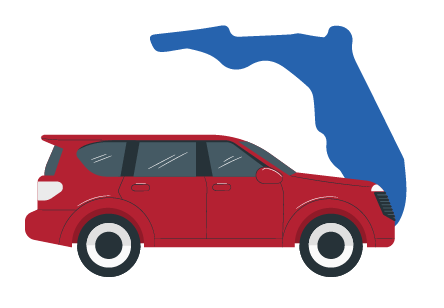Ohio law requires all drivers to have car insurance to show financial responsibility in case of an accident. Every vehicle must be insured with the state’s minimum liability coverage and carry proof of insurance while driving.
Not carrying or showing valid car insurance can result in severe penalties, including fines, license suspension, and personal liability for damages. These laws are in place to protect all drivers so they can pay for the accidents they cause.
Drivers who lease or finance their vehicles may have higher minimum insurance requirements set by their lender or leasing company. Minimum car insurance coverage meets the legal requirement, but optional coverages like collision or comprehensive coverage provide more financial protection.
Minimum Car Insurance Requirements for Ohio
Ohio law requires all drivers to show financial responsibility in the event of a car accident, usually by buying liability insurance. While other methods like posting a bond or depositing collateral are allowed, most licensed drivers choose to buy auto insurance coverage.
To meet Ohio insurance requirements, your auto insurance policy must have the following minimum liability coverage limits, written as 25/50/25:
- $25,000 bodily injury liability per person injured in an accident you cause
- $50,000 total for bodily injury liability per accident
- $25,000 for property damage liability per accident.
These minimum amounts are the maximum your insurer will pay for medical costs for third party injuries or damages in a covered accident. If costs exceed these limits, you may be personally responsible for the difference, and your personal assets are at risk.
Liability Coverage in Ohio
Liability coverage also includes legal defense if you’re sued after a covered incident. It applies not only when you drive but also when a family member or permitted driver uses your vehicle, and it usually extends to rental cars.
But liability coverage doesn’t cover your own injuries or vehicle damage. You’ll need additional coverages like personal injury protection (PIP), MedPay for medical expenses, or collision coverage for your vehicle repair or replacement.
Since the financial exposure in a serious accident is so great, many Ohio drivers carry car insurance coverage above the state minimums for more protection.
Ohio Car Insurance Alternatives
While most Ohio drivers meet the state’s financial responsibility law by buying car insurance, Ohio law allows other ways to prove financial responsibility—mainly for those who don’t want to carry a traditional auto insurance policy. The Ohio Department of Insurance and the Bureau of Motor Vehicles (BMV) regulate these options.
You can comply by choosing any of the options listed below.
- $30,000 Cash or Government Bond Deposit: Get a certificate of bond issued from the BMV stating you’ve deposited $30,000 in cash or government bonds with the State Treasurer of Ohio.
- Surety or Insurance Company Bond: Get a $30,000 bond from an authorized surety or insurance company filed with the BMV.
- Real Estate Bond: Get a $30,000 certificate of bond from the BMV signed by two property owners who each have at least $60,000 in real estate equity.
- Certificate of Self-Insurance: Available for individuals or businesses that own 25 or more vehicles, this certificate is issued by the BMV and says you can self-insure those vehicles.
While legal, these car insurance alternatives are more expensive and less convenient than buying a standard auto insurance policy. For most people, carrying a policy that meets or beats Ohio’s minimum liability limits is the most practical and cost-effective option.
Is Ohio a No-fault state?
Ohio is an at-fault, or tort-based, state. This means the driver who is found legally responsible for an auto accident is also responsible for the damages, including injuries, property damage and other losses. The at-fault driver’s auto insurance company usually pays these expenses up to the policy limits.
Ohio does not require Personal Injury Protection (PIP). In no-fault states, drivers file medical claims with their insurance company regardless of who is at fault. In Ohio, drivers must file with the at-fault driver’s liability insurance or sue if necessary.
Medical Payments Coverage (MedPay) is available in Ohio to pay medical expenses regardless of fault, but it is not required and is often not included in basic auto policies. Many Ohioans rely solely on liability to cover injuries from auto accidents, which is why it’s important to understand fault and coverage responsibilities in the state.
Optional Car Insurance Coverage in Ohio
While Ohio requires liability insurance, many drivers add more auto coverage to protect themselves, their passengers, and their vehicles from more risks. Optional car insurance coverages provide financial protection beyond the minimum required, especially in cases involving uninsured drivers, vehicle damage, or medical expenses. The most common optional coverages offered by most auto insurance companies in Ohio are listed below.
- Comprehensive Coverage: This coverage covers your vehicle for non-collision incidents such as theft, vandalism, fire, falling objects, weather damage, and animal collisions. It has a deductible.
- Collision Coverage: Pays for repairs to your vehicle if it’s damaged in a collision with another vehicle or a stationary object, regardless of who’s at fault. A deductible applies.
- Gap Insurance (Loan/Lease Payoff): This covers the difference between your car’s actual cash value and your auto loan or lease balance if the vehicle is totaled.
- Medical Payments (MedPay): Covers medical or funeral expenses for you and your passengers after an accident, regardless of fault. This coverage supplements your health insurance.
- Uninsured/Underinsured Motorist Coverage: Provides bodily injury and property damage protection if you’re hit by a driver with no insurance or not enough to cover your losses.
- Rental Car Reimbursement (Loss of Use): Pays for a rental car or other transportation costs if your vehicle is undrivable due to a covered loss so you can stay mobile while repairs are being made.
- Roadside Assistance: Offers emergency services such as towing, jump-starts, fuel delivery, flat tire repair, and lockout assistance. Plans vary by insurer and may be basic or enhanced.
- Accident Forgiveness: Some insurers offer this feature to prevent your auto insurance rates from increasing after your first at-fault accident so your rates won’t increase.
Adding these coverages to your policy can create more comprehensive insurance coverage to fits your needs and level of financial protection.
Penalties for Driving Without Insurance in Ohio
Driving without car insurance in Ohio is a big deal and can lead to big legal and financial consequences. All drivers must have at least the state’s minimum liability insurance or other approved proof of financial responsibility. If you don’t, you’ll face:
- License Suspension:
- First Offense: Immediate license suspension until you show proof of insurance and pay a $40 reinstatement fee.
- Second Offense: 1 year license suspension and a $300 reinstatement fee.
- Third Offense or More: 2 year license suspension and a $600 reinstatement fee.
- Vehicle Impoundment: Your vehicle and license plates will be impounded. To get them back, you must show proof of insurance and pay impound and reinstatement fees.
- SR-22 Requirement: You’ll usually have to file an SR-22, which proves continuous insurance coverage. This can last 3-5 years, depending on the number of offenses.
- Failure to Surrender License: A $50 fine if you don’t surrender your drivers license when required.
- Out-of-Pocket Liability: If you get into an accident and are uninsured, you’re financially responsible for vehicle repairs, medical bills, and property damage. You can also be sued for bodily injury or damage.
- Higher Insurance Premiums: Being a high risk driver will increase your future insurance rates. An SR-22 filing will also impact your driving record and insurability.
These penalties show that the uninsured risks far outweigh car insurance costs. Being in compliance protects your legal status and your wallet.
SR-22 Insurance for High-Risk Drivers in Ohio
In Ohio, certain high-risk drivers are required to carry SR-22 Insurance, which is not an insurance policy but a Certificate of Financial Responsibility that your insurance company sends to the Ohio BMV. This certificate proves you have at least the state minimum liability coverage.
An SR-22 certificate is usually required for drivers who:
- Have been convicted of DUI or DWI,
- Have been in multiple serious accidents,
- Have had their license suspended multiple times
- Were uninsured at the time of an accident.
You must have continuous coverage throughout the SR-22 filing period—usually 3 years. Suppose your policy lapses or is canceled for any reason. In that case, the BMV will be notified, and your license will be suspended immediately. Continuous compliance keeps you eligible to drive in Ohio.
Why Complying with Ohio Auto Insurance Laws Matters
Ohio auto insurance requirements are pretty straightforward. You need to have the state-mandated minimum liability coverage to drive legally. But that minimum coverage can leave you vulnerable to some pretty big financial risks if you’re in an accident. That’s why it’s a good idea to increase your liability limits or add optional coverages like collision and comprehensive insurance.
If you’re worried about the cost of that extra protection, now is a great time to shop around. Insurance Navy can help you compare coverage options and get real-time pricing from top insurance companies. Just enter your ZIP code, and you will see what’s out there.
You can compare coverage options, get quotes, and find the right fit for your budget and needs. Get a quote online or call one of our insurance agents at 888-949-6289.
Frequently Asked Questions
What are the minimum liability limits I must carry to drive in Ohio?
Ohio drivers must carry minimum liability limits of 25/50/25 (25,000 for bodily injury per person, 50,000 total for bodily injury per accident, 25,000 for property damage per accident). This coverage will help pay for expenses if you’re responsible for an at-fault accident.
Is uninsured or underinsured motorist coverage required in Ohio?
No, Ohio doesn’t require uninsured or underinsured motorist coverage; however, insurers must offer it, and you can decline it in writing. This optional coverage will pay you if you’re involved in an accident with an uninsured or underinsured driver.
What are alternatives to an auto insurance policy to satisfy Ohio’s financial responsibility law?
Ohio allows you to meet financial responsibility requirements in other ways, including posting a $30,000 surety bond or cash deposit with the state treasurer, a $60,000 real estate bond or a self-insurance certificate if you own 26 or more vehicles. These alternatives prove you have the financial means to pay for damages or injuries from an accident.
Can I show proof of insurance on my phone instead of a paper ID card?
Yes, Ohio law (Senate Bill 255) allows you to present electronic proof of insurance using your smartphone, tablet, or laptop. Since March 23, 2015, digital insurance cards have been accepted by law enforcement, courts, and the Bureau of Motor Vehicles. They are convenient and eliminate the hassle of keeping paper documents.
How soon do new residents need to get Ohio car insurance?
New Ohio residents have 30 days from establishing residency to transfer their driver’s licenses, register their vehicles, and get Ohio insurance. Comply with state requirements to avoid fines or penalties.






